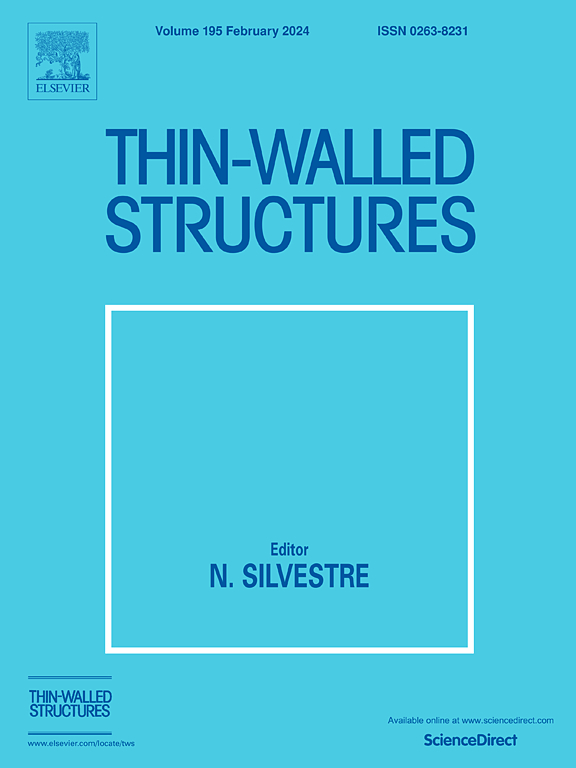Physics-informed KAN-coupled FEM for deformation analysis of complex shells
IF 6.6
1区 工程技术
Q1 ENGINEERING, CIVIL
引用次数: 0
Abstract
This study addresses the challenges of weak geometric adaptability and low computational accuracy in Physics-Informed Neural Networks (PINNs) for predicting static mechanical responses of complex shell structures. Despite growing applications of PINNs in shell static analysis, their use for complex geometries like stiffened shells remains hindered by limited network capacity, subpar training accuracy, and ineffective physical constraint enforcement. No reliable PINN solutions currently exist for such complex geometries. We propose an innovative computational framework that deeply integrates the Finite Element Method (FEM) with Physics-Informed Kolmogorov–Arnold Networks (PIKANs). The framework spatially discretizes shell structures using FEM, solves shell governing equations at each grid node, and establishes the neural network’s loss function based on these equations. Building on this foundation, an improved High-Order ReLU-KAN (HRKAN) is employed to construct the FEM-PIKAN computational model, which innovatively introduces sigmoid activation functions at the hidden layer inputs to significantly enhance the network’s nonlinear mapping capability. To validate the method’s effectiveness, systematic studies are conducted on four typical shell structures — flat plate, cylindrical shell, stiffened plate, and stiffened cylindrical shell — under body force, surface pressure, and concentrated loads. Additionally, the static response of a simplified submarine pressure hull subjected to complex loading scenarios was predicted. The results demonstrate that the proposed FEM-PIKAN method accurately predicts the static responses of various complex shell structures, providing a new paradigm for efficient and high-precision analysis of such structures. The source code is available at https://github.com/whatuphmz/FEM-PIKAN.
考虑物理因素的复杂壳变形有限元分析
该研究解决了物理信息神经网络(pinn)在预测复杂壳结构的静态力学响应时几何适应性弱和计算精度低的挑战。尽管pinn在弹壳静态分析中的应用越来越多,但它们在复杂几何形状(如加强型弹壳)中的应用仍然受到网络容量有限、训练精度欠佳以及无效的物理约束执行的阻碍。对于如此复杂的几何形状,目前还没有可靠的PINN解决方案。我们提出了一个创新的计算框架,将有限元法(FEM)与物理信息Kolmogorov-Arnold网络(PIKANs)深度集成。该框架采用有限元法对壳结构进行空间离散,求解每个网格节点上的壳控制方程,并基于这些方程建立神经网络的损失函数。在此基础上,采用改进的高阶ReLU-KAN (HRKAN)构建了FEM-PIKAN计算模型,在隐层输入处创新性地引入了sigmoid激活函数,显著增强了网络的非线性映射能力。为了验证该方法的有效性,系统地研究了四种典型壳体结构——平板、圆柱壳、加筋板和加筋圆柱壳——在体力、表面压力和集中荷载作用下的受力情况。此外,还对一个简化潜艇耐压壳体在复杂载荷情况下的静响应进行了预测。结果表明,所提出的FEM-PIKAN方法能够准确预测各种复杂壳结构的静力响应,为此类结构的高效、高精度分析提供了新的范式。源代码可从https://github.com/whatuphmz/FEM-PIKAN获得。
本文章由计算机程序翻译,如有差异,请以英文原文为准。
求助全文
约1分钟内获得全文
求助全文
来源期刊

Thin-Walled Structures
工程技术-工程:土木
CiteScore
9.60
自引率
20.30%
发文量
801
审稿时长
66 days
期刊介绍:
Thin-walled structures comprises an important and growing proportion of engineering construction with areas of application becoming increasingly diverse, ranging from aircraft, bridges, ships and oil rigs to storage vessels, industrial buildings and warehouses.
Many factors, including cost and weight economy, new materials and processes and the growth of powerful methods of analysis have contributed to this growth, and led to the need for a journal which concentrates specifically on structures in which problems arise due to the thinness of the walls. This field includes cold– formed sections, plate and shell structures, reinforced plastics structures and aluminium structures, and is of importance in many branches of engineering.
The primary criterion for consideration of papers in Thin–Walled Structures is that they must be concerned with thin–walled structures or the basic problems inherent in thin–walled structures. Provided this criterion is satisfied no restriction is placed on the type of construction, material or field of application. Papers on theory, experiment, design, etc., are published and it is expected that many papers will contain aspects of all three.
 求助内容:
求助内容: 应助结果提醒方式:
应助结果提醒方式:


